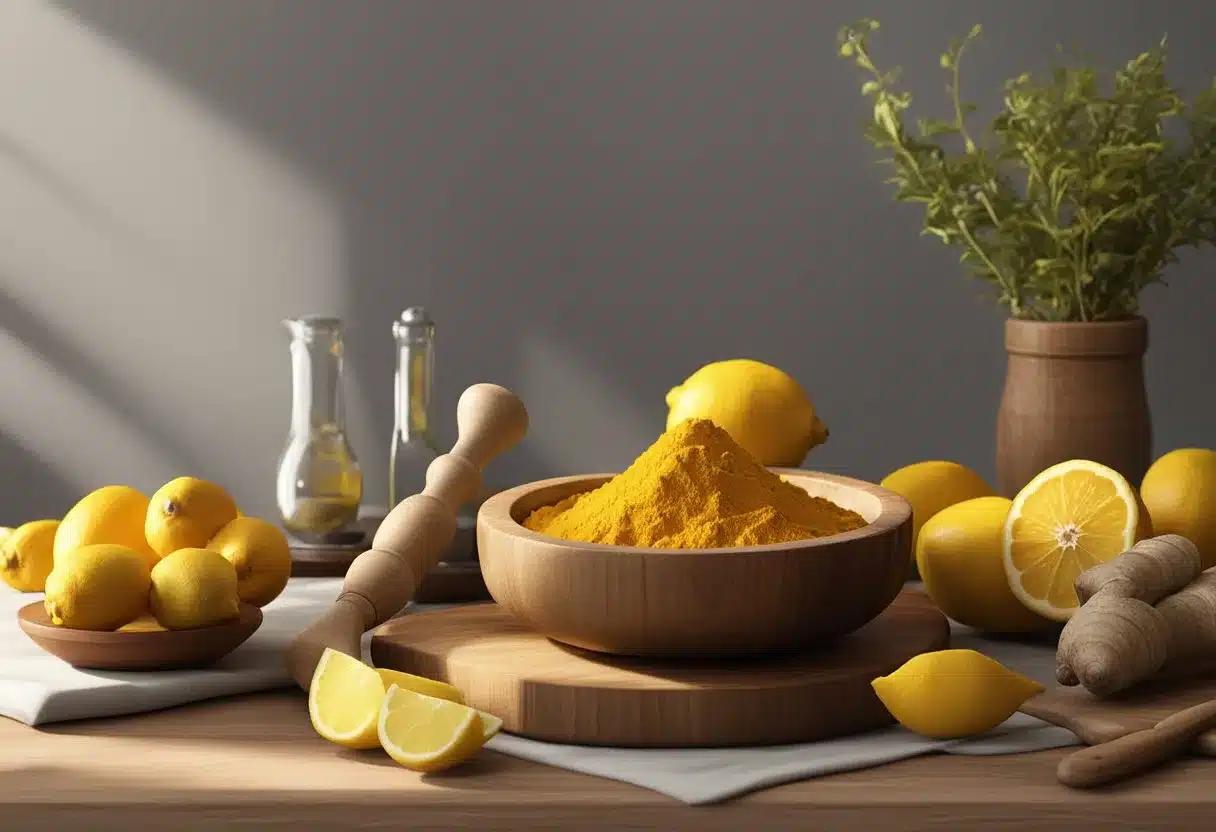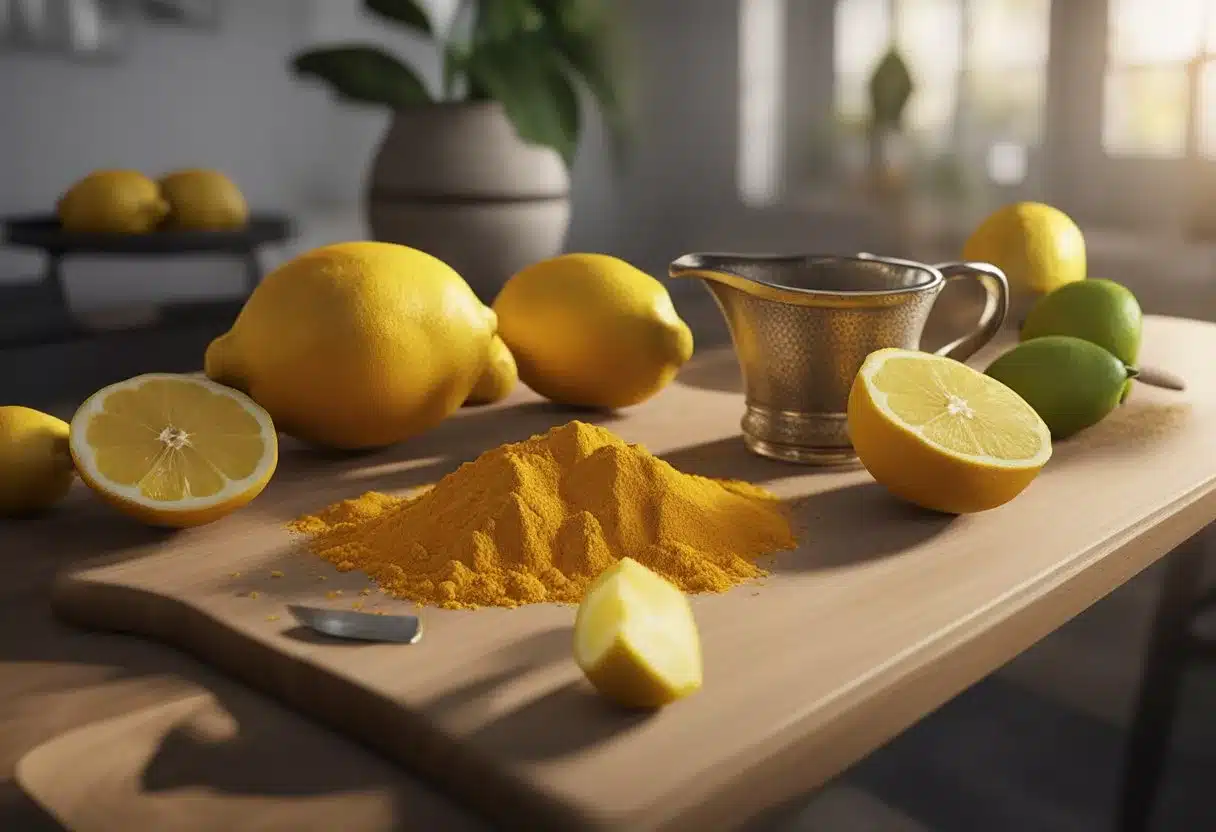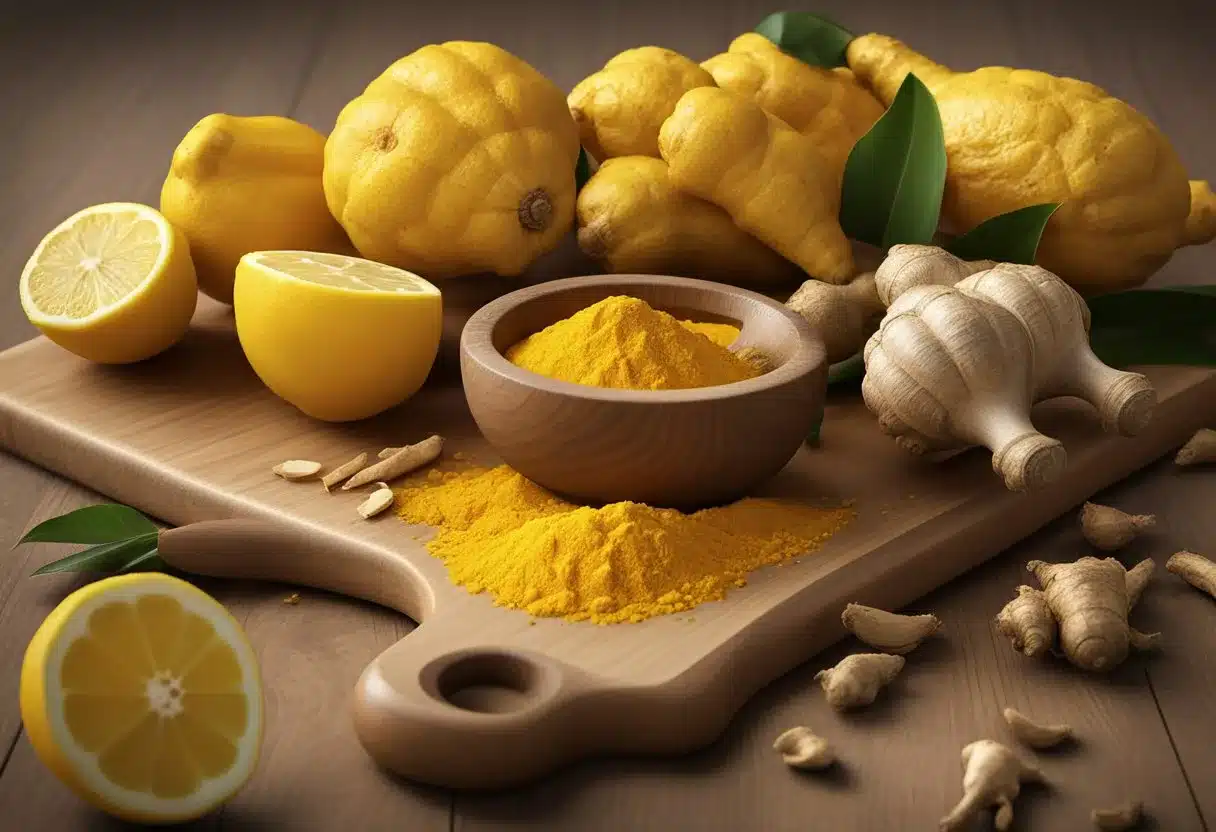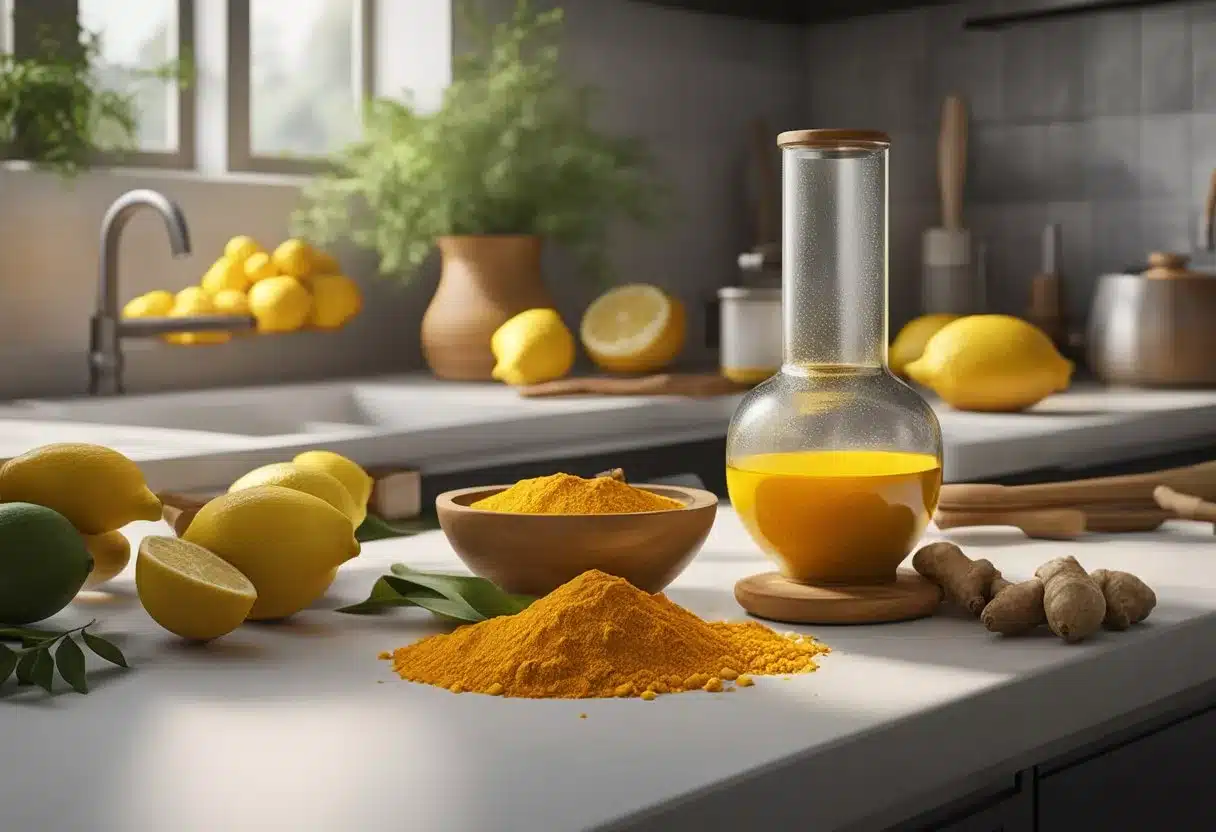Turmeric has long been celebrated for its vibrant color and numerous health benefits. A simple turmeric tonic can offer powerful anti-inflammatory properties that make it a staple in traditional Chinese and Ayurvedic medicine. These easy-to-make recipes can help boost your immune system and add a healthy routine to your daily life.

Making a turmeric tonic at home is straightforward and requires just a few ingredients. Fresh turmeric root or ground turmeric, along with lemon juice, ginger, and honey, are common components. Whether served hot or cold, this tonic is versatile and refreshing.
In addition to its health benefits, turmeric can be easily incorporated into your diet through these recipes. By preparing a turmeric tonic, you can enjoy a delicious drink that supports your overall well-being. Check out these easy methods to make your own turmeric tonic and feel the difference.
Key Takeaways
- Turmeric tonic offers anti-inflammatory benefits.
- Easy recipes include simple, accessible ingredients.
- Homemade tonics can support overall health and wellness.
The Essentials of Turmeric

Turmeric is a powerful spice known for its vibrant color and significant health benefits. It contains curcumin, an active compound with notable anti-inflammatory properties.
Understanding Turmeric
Turmeric is a bright yellow spice widely used in cooking, especially in Indian and Middle Eastern cuisines. It comes from the root of the Curcuma longa plant. The spice is often found in ground form, but fresh turmeric root can also be used in recipes.
Turmeric is lauded for its potential health benefits. It is rich in fiber, carbohydrates, protein, and small amounts of fat. The spice is believed to help with digestion, reduce inflammation, and even boost the immune system. Including turmeric in your diet can add color and a warm, earthy flavor to dishes.
Curcumin: The Active Compound
Curcumin is the primary active compound in turmeric. This compound is responsible for many of the spice’s health-promoting properties. Curcumin has strong anti-inflammatory effects and is a powerful antioxidant.
Research indicates that curcumin may help reduce symptoms of inflammation-related conditions, such as arthritis. It is also being studied for its potential role in preventing certain diseases. While turmeric contains a small percentage of curcumin, using it regularly in your meals can still be beneficial.
Curcumin’s bioavailability, or its ability to be absorbed by the body, can be enhanced by consuming it with black pepper. The piperine in black pepper improves curcumin absorption significantly, making it more effective.
Turmeric Tonic Benefits

Turmeric tonic is known for its wide range of health benefits. These include anti-inflammatory advantages, improved digestive health, and strong support for the immune system.
Anti-Inflammatory Advantages
Turmeric contains a compound called curcumin, which is known for its anti-inflammatory properties. Curcumin helps reduce inflammation in the body, which can help with conditions like arthritis. Consistent consumption of turmeric tonic can ease joint pain and improve mobility.
Chronic inflammation is linked to many health problems, including heart disease and cancer. By incorporating turmeric tonic into your daily routine, you might lower the risk of these diseases. The anti-inflammatory effects make turmeric tonic a valuable addition to maintaining overall well-being.
Digestive Health
Turmeric tonic aids in digestion by stimulating bile production in the liver. This can lead to better digestion of fats and other nutrients, making it easier to absorb essential vitamins and minerals.
For those with digestive issues like bloating or gas, turmeric tonic can offer relief. The tonic’s natural ingredients, like ginger, further support digestive health by relaxing the gastrointestinal system. Drinking turmeric tonic regularly can help maintain a healthy digestive tract.
Immune System Support
Turmeric tonic has potent antioxidant properties that support the immune system. These antioxidants neutralize free radicals in the body, which can otherwise lead to cell damage and weaken immunity.
The tonic’s ingredients, such as lemon and ginger, are known for their immune-boosting effects. Lemon provides vitamin C, while ginger has antimicrobial benefits. Together, they enhance the immune system’s ability to fight off infections. Adding turmeric tonic to your diet can thus contribute to better immune health.
Preparing Your Tonic

Preparing your turmeric tonic involves selecting the right ingredients, ensuring their freshness, and using the appropriate tools and equipment.
Selecting Ingredients
Choosing the right ingredients is crucial for the best flavor and health benefits. Fresh turmeric and fresh ginger are the stars of the tonic. They should be peeled and sliced thinly to release their full potential. Lemon juice adds a zesty kick, while honey provides a touch of sweetness. Black pepper enhances the absorption of curcumin from the turmeric.
Optional ingredients like cayenne pepper and maple syrup can be added for extra heat and flavor complexity. Using quality ingredients ensures that your tonic is both delicious and effective.
The Importance of Freshness
Freshness is key to getting the most out of your turmeric tonic. Fresh turmeric and ginger roots bring vibrant color and potent flavors that dried spices can’t match.
Using fresh, peeled turmeric and ginger boosts both the taste and nutritional value of the tonic. Fresh lemon juice is preferred over bottled to avoid preservatives and obtain a more natural taste. Fresh ingredients not only taste better but also ensure you’re getting the maximum health benefits.
Tools and Equipment
Having the right tools and equipment makes preparing your tonic simple and efficient. You’ll need a small saucepan to simmer the ingredients. A blender can be used if you prefer a smooth texture.
After blending, use a sieve to strain out fiber for a clearer tonic. A sharp knife or vegetable peeler will help to peel the turmeric and ginger. Having these tools at hand ensures a smooth process from start to finish, making your kitchen experience enjoyable and hassle-free.
Preparing a turmeric tonic doesn’t need to be complicated. With the right ingredients, focus on freshness, and the proper tools, you can easily make a delicious and healthy drink.
Step-by-Step Recipes

Here are some easy turmeric tonic recipes that combine ingredients like lemon juice, ginger, honey, and coconut water to create refreshing and healthful beverages.
Basic Turmeric Tonic
Start with 1 cup of water and bring it to a simmer in a small saucepan. Add 1 teaspoon of ground turmeric, 1/2 teaspoon of fresh grated ginger, and a pinch of black pepper. Let it simmer for about 5 minutes. Strain the mixture into a mug. Add 1 tablespoon of lemon juice and 1 teaspoon of honey to taste.
Ingredients:
- 1 cup water
- 1 teaspoon ground turmeric
- 1/2 teaspoon fresh grated ginger
- Pinch of black pepper
- 1 tablespoon lemon juice
- 1 teaspoon honey
Citrus and Spice Tonic
In a pot, heat 2 cups of coconut water. Add 1 inch of sliced fresh turmeric root, 1 inch of sliced fresh ginger root, and 1/4 teaspoon of cayenne pepper. Simmer the mixture for 10 minutes. Strain and pour into glasses. Add the juice of 1 lemon and 1 orange. Sweeten with 2 tablespoons of maple syrup if desired.
Ingredients:
- 2 cups coconut water
- 1 inch fresh turmeric root (sliced)
- 1 inch fresh ginger root (sliced)
- 1/4 teaspoon cayenne pepper
- Juice of 1 lemon and 1 orange
- 2 tablespoons maple syrup (optional)
Sweet and Soothing Tonic
Combine 1 cup of water, 1 tablespoon of ground turmeric, and 1 tablespoon of grated ginger in a saucepan. Bring to a simmer for 5 minutes. After simmering, strain the liquid into a mug. Add 2 teaspoons of honey and 1 tablespoon of lemon juice. Stir well and serve warm.
Ingredients:
- 1 cup water
- 1 tablespoon ground turmeric
- 1 tablespoon grated ginger
- 2 teaspoons honey
- 1 tablespoon lemon juice
Tropical Turmeric Blend
In a blender, mix 1 cup of coconut water, 1/2 cup of pineapple juice, 1/2 teaspoon ground turmeric, and 1/2 teaspoon grated ginger. Blend on high until smooth. Pour into a glass and squeeze the juice of half a lime. Garnish with mint leaves if desired for an extra refreshing touch.
Ingredients:
- 1 cup coconut water
- 1/2 cup pineapple juice
- 1/2 teaspoon ground turmeric
- 1/2 teaspoon grated ginger
- Juice of half a lime
- Mint leaves (optional)
These recipes are simple to follow and each offers a unique flavor profile, ensuring there’s a turmeric tonic to suit every taste.
Enhancing Your Tonic

Adding different ingredients can boost the flavor and health benefits of your turmeric tonic. Experimenting with sweeteners and herbs can make your tonic both more delicious and nutritious.
Creative Sweeteners
Creative sweeteners such as honey, maple syrup, and raw honey can enhance the taste of a turmeric tonic. Honey and raw honey not only add sweetness but also bring antibacterial properties. Maple syrup offers a distinct flavor and contains beneficial vitamins and minerals.
Sugar might also be used sparingly for those who prefer a traditional taste.
Sweeteners blend well with turmeric and lemon, balancing the slight bitterness and offering a pleasing taste while still providing health benefits like antioxidants and vitamin C.
Herbal Infusions
Herbs like ginger, lemon, and apple cider vinegar add depth to a turmeric tonic.
Ginger pairs well with turmeric, adding a spicy kick and additional anti-inflammatory properties. Lemon not only enhances the flavor but also boosts vitamin C content, promoting a healthy immune system.
Apple cider vinegar can be included to add a tangy taste and improve digestion.
Herbal infusions such as these can turn a simple turmeric tonic into a powerful health drink that supports overall well-being.
By mixing in different herbs, the tonic can become more flavorful and beneficial.
Nutritional Profile

Turmeric tonics pack a variety of nutrients that contribute to your overall health. They provide essential vitamins and minerals while being low in calories and fats.
Caloric and Macronutrient Breakdown
Turmeric tonics are low in calories, making them a healthy addition to your diet. Typically, a serving might contain around 20-30 calories.
Macronutrient content:
- Protein: Minimal, around 0.5 grams.
- Carbohydrates: Mostly from natural ingredients like honey or lemon juice, usually up to 7 grams.
- Fat: Generally less than 1 gram, with very little saturated or trans fat.
Low in cholesterol and sodium, turmeric tonics are a heart-friendly option.
Vitamins and Minerals Content
Turmeric tonics are rich in several essential vitamins and minerals.
Key nutrients:
- Vitamin C: Boosts immune function and skin health.
- Potassium: Important for muscle function and fluid balance.
- Calcium: Supports bone health.
- Iron: Vital for red blood cell production and oxygen transport.
Additionally, turmeric contains curcumin, known for its anti-inflammatory properties.
Including spices like ginger and additives such as lemon can further enhance the nutrient profile of these tonics.
These beverages are a nutritious way to enjoy the benefits of turmeric while supporting your overall health.
Serving and Storage Tips

When enjoying a turmeric tonic, it’s crucial to serve it properly and store it correctly to maintain its flavor and health benefits. This section will cover the best practices for serving turmeric tonic and how to store any leftovers for optimal freshness.
Best Practices for Serving
To serve turmeric tonic, it’s best to use filtered water to ensure the purest taste. For a hot beverage, pour the tonic into mugs, which help retain the warmth. For a refreshing cold option, serve the tonic over ice in tall glasses.
Adding a slice of lemon or a pinch of black pepper can enhance the flavors and boost the tonic’s health benefits. Black pepper is particularly recommended as it helps the body absorb curcumin, the active compound in turmeric. The tonic can be garnished with a mint leaf for extra freshness.
Proper Storage for Longevity
To store turmeric tonic, make sure it is cooled to room temperature before placing it in the refrigerator. Use an airtight container to preserve its flavors and prevent contamination. The tonic can be stored for 2-3 days.
Glass containers are preferred over plastic, as they do not absorb odors or stains. If the tonic is stored for more than a day, give it a good shake before serving to mix any settled ingredients. This ensures a uniform taste and consistency.
By following these steps, you can enjoy a fresh and flavorful turmeric tonic anytime.
Dietary Considerations

Turmeric tonics can be adapted for various dietary needs. These adaptations ensure that everyone can enjoy the benefits of turmeric, regardless of their dietary restrictions.
Vegan and Vegetarian Adaptations
For a vegan or vegetarian turmeric tonic, replace any animal-derived ingredients. Common swaps include using coconut milk instead of regular milk and maple syrup or agave instead of honey for sweetness.
This makes the tonic entirely plant-based yet still flavorful and refreshing. The use of turmeric, ginger, and lemon remains unchanged. These ingredients are naturally vegan and provide health benefits such as anti-inflammatory properties.
Using coconut water instead of regular water adds a subtle sweetness and smooth texture, further enhancing the tonic’s appeal without compromising on the vegan aspect.
Adjustments for Dietary Restrictions
Ensuring the turmeric tonic is gluten-free is straightforward. Most recipes already do not include gluten-containing ingredients. If adding any premade ingredients like syrups, double-check that they are certified gluten-free.
For those avoiding sugar, omit sweeteners like honey or maple syrup, and consider natural sweet alternatives like stevia. This keeps the tonic healthy and maintains its anti-inflammatory benefits.
People with dietary sensitivities can also opt for low-FODMAP versions. Avoid ingredients high in FODMAPs and focus on using fresh turmeric, ginger, and lemon. Adding a bit of pepper can help increase the absorption of curcumin, turmeric’s key beneficial compound.
Additional Applications

Turmeric is versatile and can be incorporated into your diet in many ways beyond just tonic recipes. Its distinct flavor and health benefits make it a valuable addition to various dishes and drinks.
Turmeric Beyond the Tonic
Turmeric is popularly known for its use in tonics like golden milk and jamu. Golden milk is a warm drink made with milk, turmeric, and spices. It is often enjoyed as a soothing beverage before bedtime.
Jamu is an Indonesian herbal drink that usually includes turmeric, ginger, and lemon juice. It is prized for its anti-inflammatory properties and potential benefits for liver health.
Turmeric lattes are another trendy option. These drinks replace coffee with a blend of turmeric, milk, and spices, offering a caffeine-free alternative.
Integrating Turmeric into Meals
Turmeric goes beyond beverages and can be seamlessly integrated into various meal recipes. It is a common ingredient in curries, giving them their characteristic yellow color and rich flavor. Adding turmeric to curries not only enhances taste but may also provide benefits for arthritis due to its anti-inflammatory properties.
Salad dressings can be another way to incorporate turmeric. Mixing turmeric with olive oil, lemon juice, and salt creates a vibrant and healthful dressing.
Turmeric-infused rice and pilafs are excellent side dishes, making meals more flavorful and nutritious. This spice also pairs well with roasted vegetables and as a seasoning for meats.
In summary, turmeric’s adaptability allows it to be a staple in both drinks and meals, making it easy to add its unique flavor and health benefits to your diet.
Frequently Asked Questions
Turmeric tonics are popular for their potential health benefits, including anti-inflammatory properties and support for joint health. Below are answers to specific questions about creating and using these tonics.
What are the steps for creating a turmeric ginger tea aimed at weight loss?
To make turmeric ginger tea for weight loss, blend 1½ inches of ginger root, ½ inch of turmeric root, 1½ tablespoons of honey, a pinch of black pepper, 2½ cups of water, and juice from one lemon. Strain the juice and serve it over ice. This tea may support weight loss efforts.
Which ingredients enhance the anti-inflammatory effects of a turmeric tonic?
Ingredients like fresh ginger, lemon juice, honey, and black pepper can enhance the anti-inflammatory effects of a turmeric tonic. Ginger and lemon provide additional anti-inflammatory properties, while black pepper aids in the absorption of curcumin, the active component of turmeric.
How do you prepare a turmeric and ginger drink specifically for joint pain relief?
For a joint pain relief drink, boil 2 cups of water with sliced ginger and turmeric roots. Let it simmer for 20 minutes. Add honey and black pepper to enhance absorption of curcumin. Serve hot or cold.
What are the health benefits associated with regularly consuming turmeric tonic?
Regular consumption of turmeric tonic can support joint health, reduce inflammation, and boost the immune system. Turmeric is also known for its antioxidant properties and potential to improve digestion and heart health.
Can you suggest a simple ginger tonic recipe that complements the properties of turmeric?
A simple ginger tonic requires blending 1½ inches of ginger root, juice from one lemon, 2 cups of water, and a tablespoon of honey. Strain before serving. This ginger tonic pairs well with turmeric for potential enhanced health benefits.
What are some ideal pairings for turmeric in a beverage to maximize its health benefits?
Ideal pairings for turmeric in a beverage include ginger, lemon juice, honey, and black pepper. These ingredients not only complement the taste but also support the absorption and effectiveness of turmeric’s active compounds.